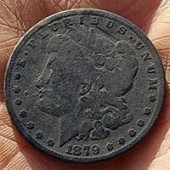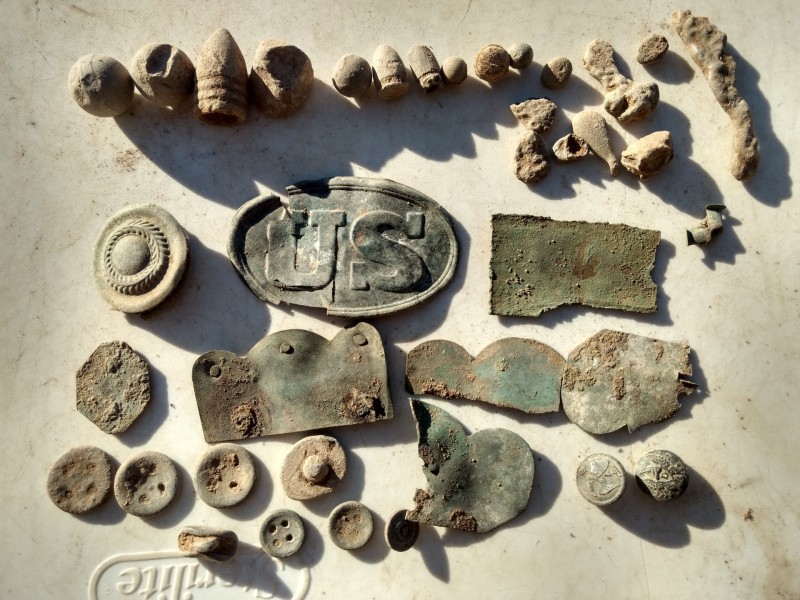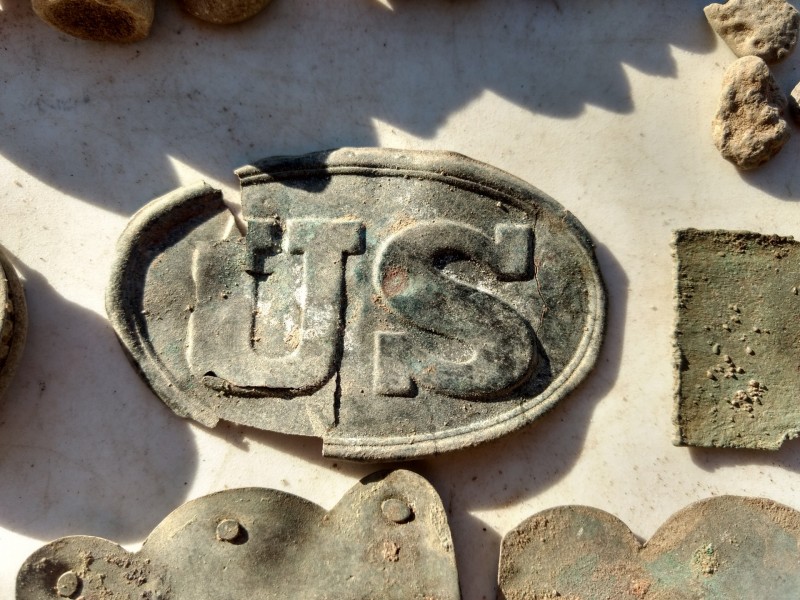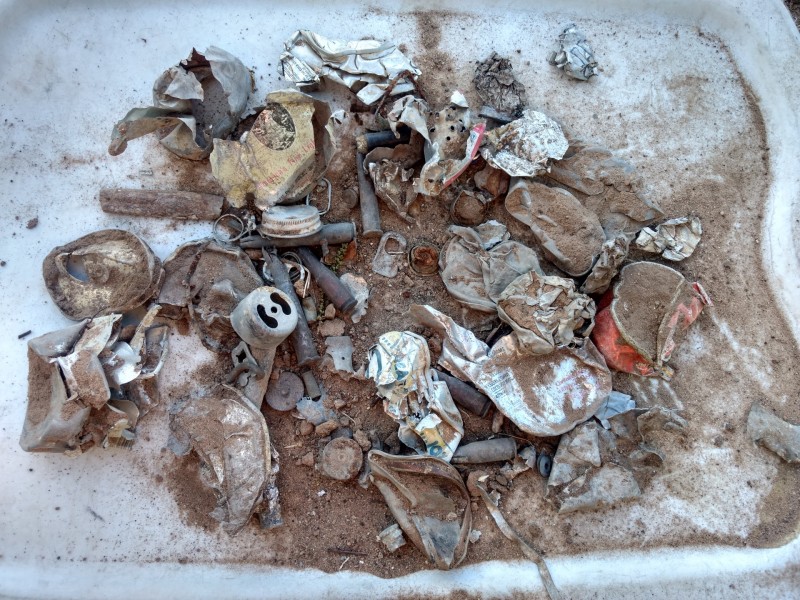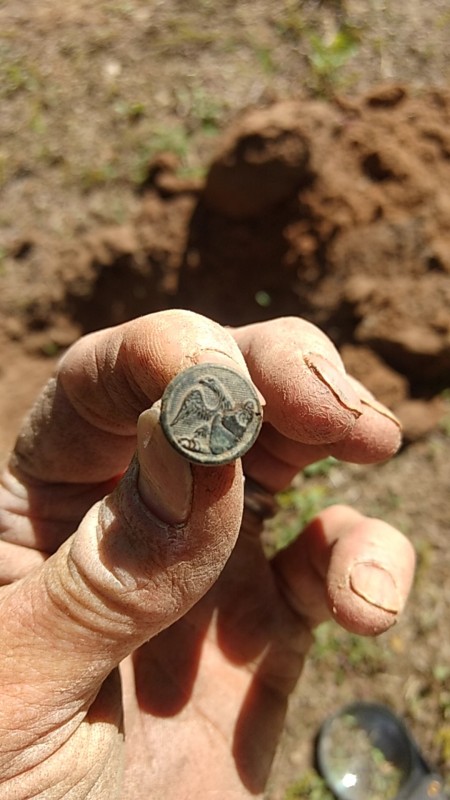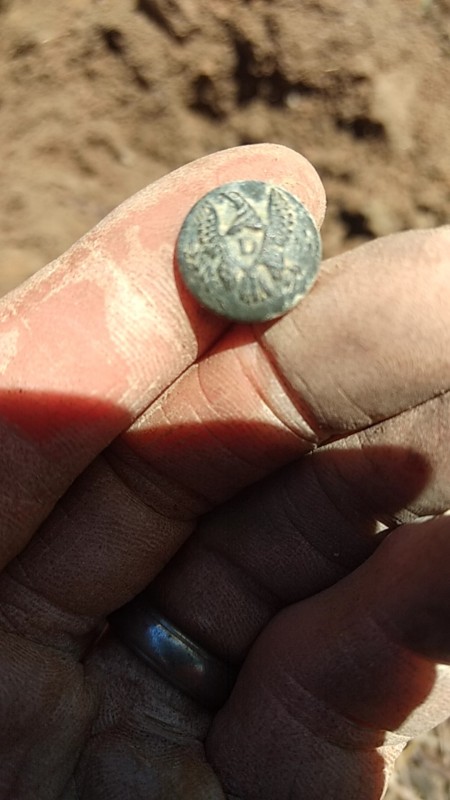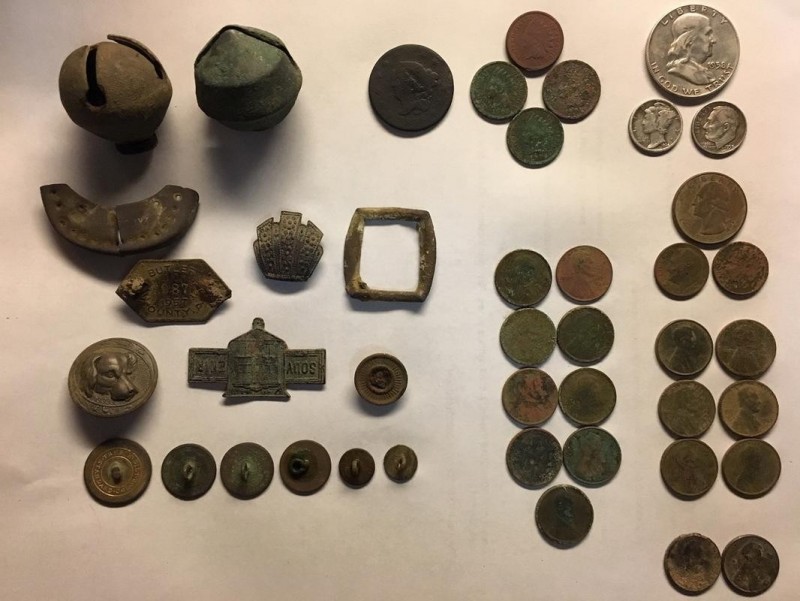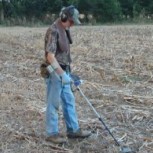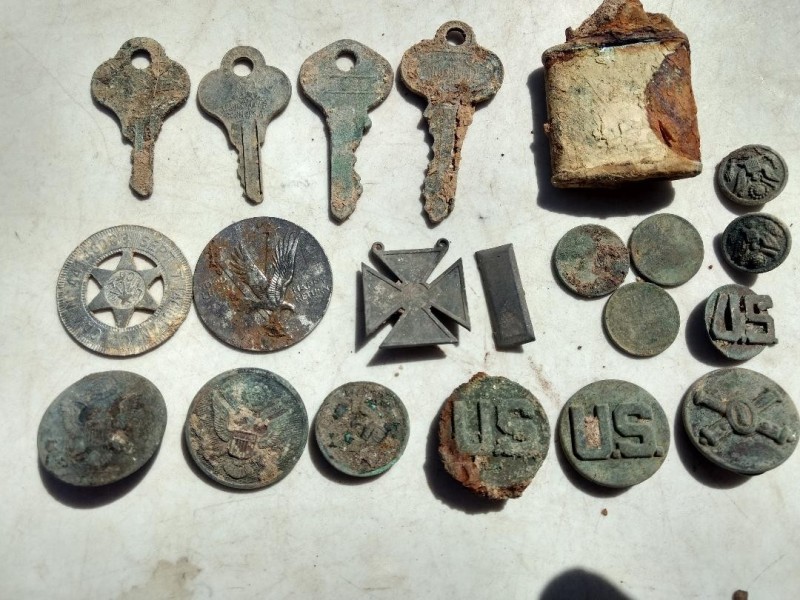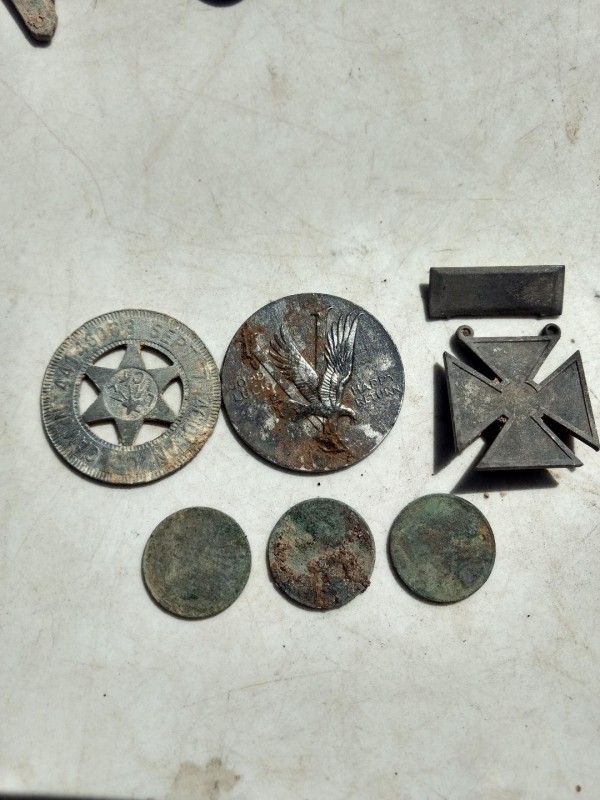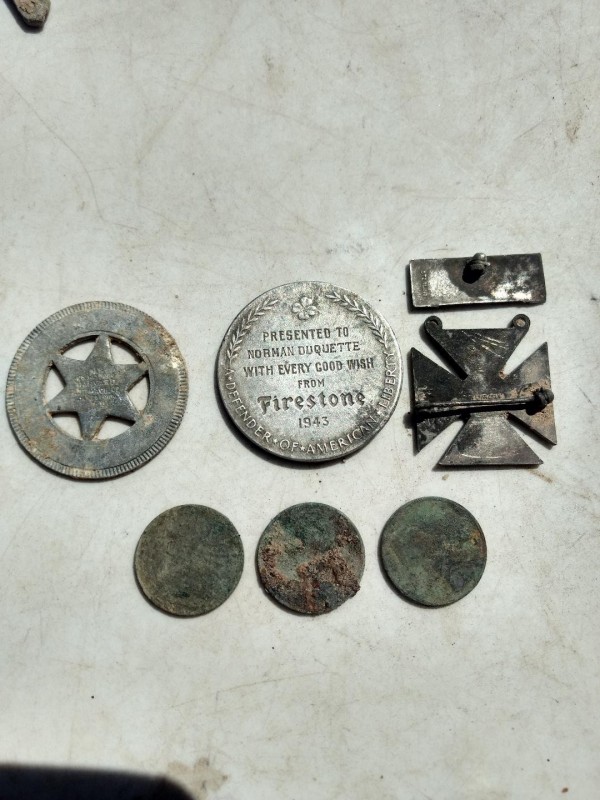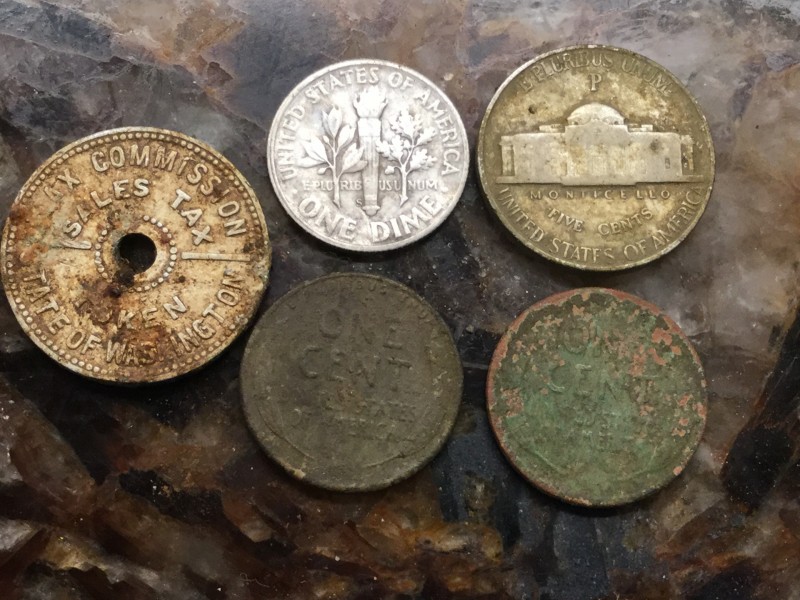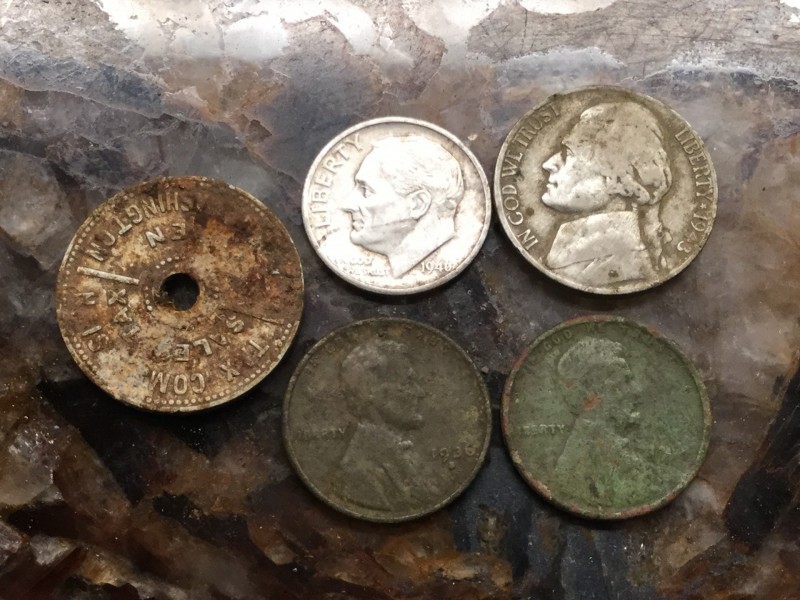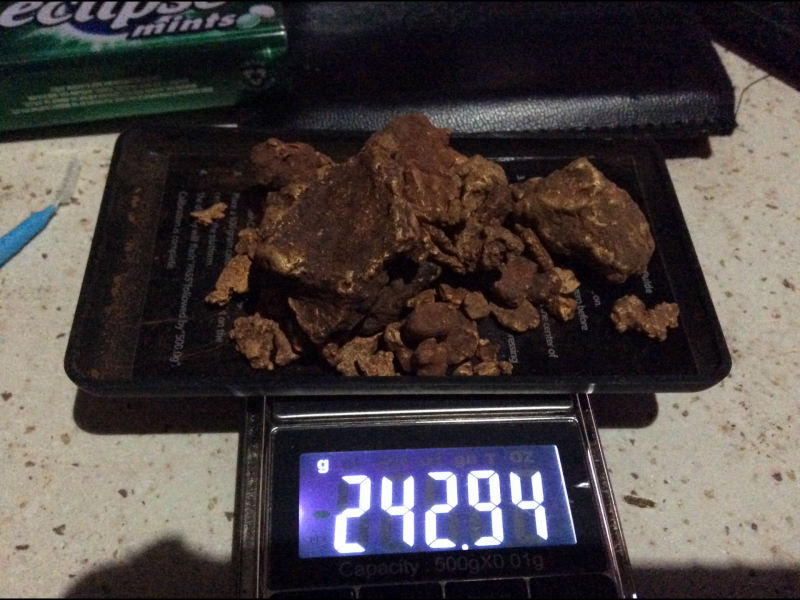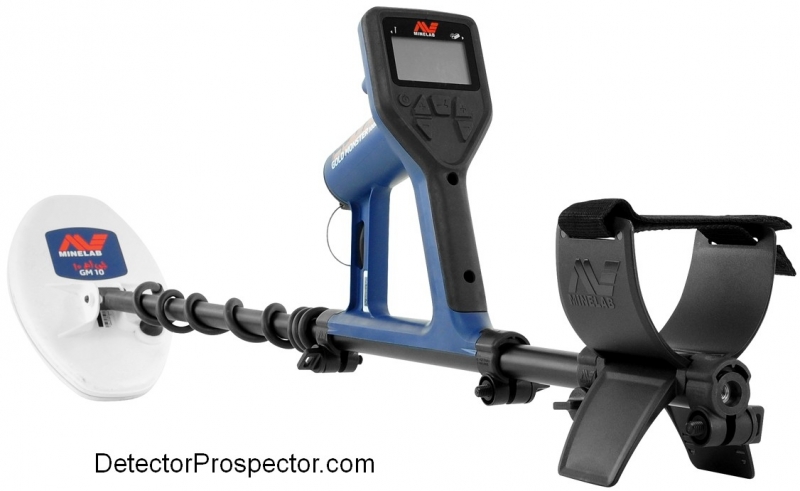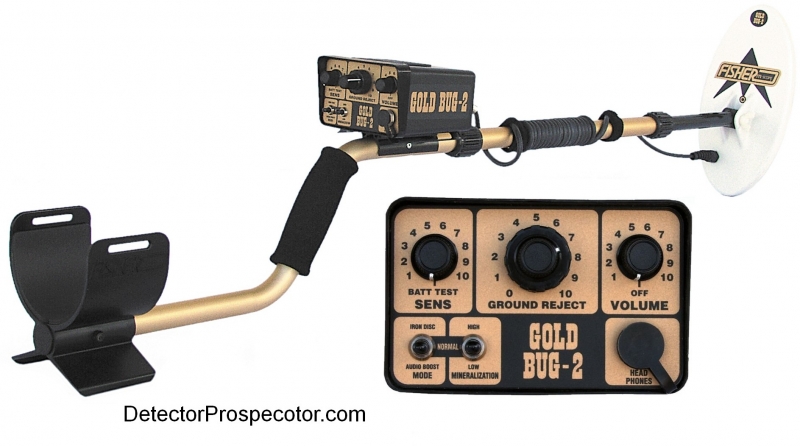Leaderboard
Popular Content
Showing content with the highest reputation on 05/06/2019 in all areas
-
So I titled this as such because when it gets especially hot (here in Arizona) I start my hunts at midnight and go thru until the morning until about 8am. For me, this offers multiple benefits. There is more time with the family on weekends, which for me is #1; I cherish this more than gold. And secondly, if it is hot out, I cannot keep my ground balanced, as some put it. When it starts getting hot, I would tend not to look as hard and rush through areas. Anyways, back to the gold. I was in a wash last week when I ran into some pretty good gold. I found 11 small pcs adding up to almost 4 grams. Now, for my night hunts, I won’t go every weekend, I usually skip 1 or two so that I get my sleep cycle working again. But then there is Mother’s Day coming up and so my wife briefly mentioned that I should go this weekend, too. An hour later I am charging batteries. She walks by and says, “wow, you really have the fever don’t you”. I just laughed. She knows me. She has seen me prospecting for 5 years and put up with it for 5 years. One of the best decisions I made was marrying her. I explain all of this because it was nice to come home and show her the source of the fever. So I went back to this area with my GPZ and started walking through more washes I had marked out on my gps. Nothing for the first one, but the second one, I got a nice strangely shaped 2.75 grammer. Now, I can kinda see a patten on my gps when I look at my finds. I finish the wash and go to a wash that is in the direction of the gold distribution. Good topography … I am in. First couple of minutes of slow hunting in this wash yields, nothing. And then I start focusing on a bench that is maybe a foot higher than the rest of the wash… and I get a signal. A clear, still loud, but smooth signal. My heart jumps as I begin to dig. The dirt just fell away until 15-16” I hit gravel. By now the target was booming. I scrape the gavel back with my pick and I see a large piece of gold flip out! It replays in my mind over and over. Needless to say, you may have heard my scream at 2:15 in the morning (Arizona time). LOL. From there the gold kept coming. I got a couple more pieces farther up the wash and then came back and placered the area for a couple more little ones missed by depth. Wide range of sizes. THAT is why I love the GPZ. And it was nice to see my wifes face change to a smile when she felt the .86oz chunk fall into her hand. Priceless. All in all, my findings came to just over 1oz. Who needs sleep ... Andyy7 points
-
I agree with JW - dig them all. I did find small lead shot was a consistent, rounded noise whereas tiny gold gave a similar noise but with a crackle to it. Almost always knew when it was a less than 0.25 gram piece as it all sounded similar. But I also got gold that sounded exactly like lead shot. And 2 of my bigger pieces I was 100% that I was digging an old square nail. If you are trying to discriminate with a GPZ my feeling is you will be leaving gold behind. JMHO ?5 points
-
4 points
-
10 hours until wheels up for ..... Queensland goldfields...(lol) yeah thats it Queensland or Victoria--not sure which, but i do know thats where the gold is---- laying on the ground in heaps after that last tectonic plate shift !!!! I heard rumors of gold squirting up out of the ground and landing like pillow lava.... be sure and get a good ute or you wont be able to carry the nuggets back... Too bad they also said that tectonic shift causedd a major dip in WA and all the gold there is now 300 met4ers deeper than it was before-- Guess i can get some beach hunting in and then go seemy new fillapina wife if I get bored.... May have to hook up with Norvic and DaveW to get any real gold this year...... See ya all around -----?----Cheers you lucky dogs!4 points
-
Hi all! I just returned from a short vacation back home in western PA, and squeezed in a couple of hunts at a few old sites -- an 1872 farmhouse, an 1885 house, an early to mid 1800s foundation, and a 19th century cellar hole...plus a short time at an old church or school house estimated to be late 1800s. I managed a nice variety of finds; here are some of the better ones. The large cent is 1818, the pinkish-looking Indian is an 1863 fattie. There is writing on most of the flat buttons, but the only ones I can make out are the gold-gilded one that says "TREBLE GILT STANDARD COLOR," and one other that says "SUPERFINE STRONG LONDON." Does anyone know any ages on those? The round crotal bell says "OCT 24 76 & MAY 14 78" -- and has a maker's mark that has a small circle, then a diamond with a plus inside, and then another small circle. The other, acorn-shaped bell has no markings... Steve4 points
-
The only consistent noise a tiny nugget makes,is the rattle in the keep jar.4 points
-
I hate to distract us from the spirited discussion of ZED aftermarket coils and new gold detectors, but I've been working on a plan to spend a few months downunder detecting WA. I sold some gold to finance the operation and convinced my Baja detecting partner we need to get us some Aussie gold. Just so you know I'm not a idiot and going off half cocked here, I purchased the premium edition of Nurse Paul's primer "Yank's guide to plundering Aussie Gold". Some very helpful information..."when handling sharp digging tools, always wear flip flops". Or the timeless, "When drinking a few cold ones with the locals, the acceptable ratio is 3 to 1. Buy 1, drink 3, it makes them feel superior." What could possible go wrong with that kind of wisdom at my disposal? Yeah I know, $16,000 worth of detectors got stolen while he slept on watch, but that could have happened to anyone. He's matured alot since then. Seriously though, we leave May 19 and don't expect to return until my 90 day visa expires. Paul has in fact helped me get a handle on the geography, Ute selection and basic gear requirements. We'll be boondocking it, living on road kill and brown snakes with a case of Vegimite for emergencies. I've already purchased one of the new X-coils 17" for the Zed which will be waiting for me when I arrive. I had a sacrificial coil cable for the jumper connection since I destroyed the original 14" stock coil, long story, but apparently you're not supposed to drag that coil behind the Rokon at cruising speed down desert dirt roads for a couple miles. Who knew they were so fragile? Wore right through the plastic housing and exposed the copper windings, bummer. But, I've got me a $900.00 Minelab chipped coil cable so the glass is half full. Nevertheless, an adventure is at hand. I'll post updates and photos as opportunities present.4 points
-
“A man who unearthed a £145,000 Anglo-Saxon pendant has found more treasure dating back about 800 years. Tom Lucking's latest find saw him dig up a brooch dating back to between 1200 and 1300 in Wymondham, Norfolk in September. In 2014, the then student found a pendant in Winfarthing, Norfolk dating from circa 630AD. Mr Lucking, 27, said the brooch, which features two lions and is studded with two pink stones, was a "special" find.” Full story and photos here3 points
-
Everyone's input matches and clarifies what I have always done with the GPX and the GPZ - dig (mostly), everything. I have found gold with almost every sound the detector makes as well (except for waltzing Matilda) but decided to ask my kind-of-stupid question to get clarification from the forum inhabitants. Thank you all.3 points
-
Now you'll have started something. JW and Phrunt will be along any minute...?3 points
-
Northeast, the lambs were very time demanding, so I ended up giving them to a lady who who was a wool classer and who had sheep of her own. She said they were very well bred and would be wool producers. I did get quite attached to Jackie, as she had real personality.3 points
-
How did you get hold of that phrunt???? Do you want to spoil my image?3 points
-
3 points
-
2 points
-
The way a signal sounds can have a lot to do with were the GB position ends up relative to the ground your working and the Gold mode and Ground Mode you are working in. A signal response in High Yield Difficult can sound a lot different in High Yield normal or any of the General modes. Generally smaller targets go High/Low in High Yield and bigger more solid bits go Low/High. Shallow Steel objects will often go Low/High but will be a tight signal response due to distance from the coil. This all changes around somewhat if the timings are changed. Quiet often you can also receive a confused signal or as a friend of mine likes to describe them, a turkey gobble signal (maybe even Waltzing Matilda ? ), this is where both channels respond equally and try to cancel each other out a little like noise cancelling does. JP2 points
-
At this point in time I think we are decades in to understanding the "dig it all" mantra, and in my opinion there isnt much left to discuss since it's a simple concept that everyone already agrees on. So it kind of surprises me to see how many serious detectorists are content at leaving it there. The more interesting thing to me is when not to dig it all. If anyone thinks there is never a time to pass over targets then I guarantee you are missing more gold by being stuck in old ways than by realizing you can produce more by knowing there is a time to pass some targets up. Consider some basic math, a philosophy which i used dredging and carried over to detecting. Let's say we accept 20% losses because I alter the sluice so it doesnt clog so much and I can run material faster over it (by removing the hungarians as an example) in return for doubling the material I run. In dredging that means I get 8 grams for running the same material instead of 10 grams. But I've doubled my material I run so I actually get 16 grams instead of 10 grams at the end of the day. Same with detecting. Covering more ground is like running more material dredging. I accept say 20% loss of nuggets I miss in return for operating in a way that let's me cover 2x more land. That's actually an underestimate, I probably cover 3 to 10x as much land as a lot of the dig it all people I see detecting cover in a day. An average day detecting on my GPS is 2 to 7 miles walking, usually 4 miles a day is pretty normal. If I am comfortable getting 80% of the gold in half or less if the time and then moving on and finding a new area, not only do I find more gold than if I stayed and dug every target in the end, but I end up with far more known producing areas discovered at the end of the season. And I go back to these areas at the end of the day if I've been skunked exploring and then THAT'S the time to grid and dig em all, and I end up with a lot of these areas in my back pocket to rely on whereas someone who stayed and just dug everything now has nothing left and no new discoveries either, starting from scratch every time. My way always keeps you in the gold and producing. Not just good for the pocketbook, but for the mental condition as well where going on skunk runs can be demotivating. All that aside, having done this for years, I've discovered that even when I'm being highly selective I'm still only missing about 10% of the overall gold I end up finding when I do finally go back and clean up every single trash target. Yet I easily produce 2, 3 maybe even as much as 10x more gold per trip than I would if I simply stayed and dug everything until it was gone. This is how you make detecting pay for itself if you aren't retired or depend at least some on the income you make finding gold. What isnt communicated properly when green horns read forums and threads like these is that a lot of the dig everything guys in the US who make fabulous finds are in fact just in tiny areas of private land or leased land which no one has access to, or claims which have been in the family for decades or longer, with heavy equipment at work. These people can afford to dig everything because they dont need to explore as much as the newer guys do. And a lot of other guys are shown places to go and dont have to put the work in to find them or go on 3 week long skunks and question why they ever bought a detector to begin with after digging 600 pieces of tin. Having recently spent a large amount of time cleaning out old "80%" areas I left behind for later, I've discovered that actually I got closer to 90 or 95% by selectively digging, and that's well within what I consider acceptable. A lot of age old mantras are repeated for a reason, because they are correct. But the trick is understanding when they aren't. For instance, there are perfectly good times you dont want to keep your coil perfectly flat even though coil control on the forums would make you think there is a school marm waiting at every patch to rap your knuckles if you dont. Any different response you can get from a detector is potentially useful information. Data needs to be correlated and interpreted to your specific conditions, and tested and compared to see if it's a bad habit or potentially useful information. This is why I cant get behind this school of thought that seems to be getting common around forums that testing, measuring and comparing is not worth the time. This stuff has all been the key to my success as a person that started without anyone to help or show me where to go. And I know most random people starting out are finding themselves in the exact same boat as I was in, so if you are one of those new guys I'm letting you know that there are other ways to do this stuff, some of which are probably better for the conditions we find ourselves in today, and especially if you dont have a friend or buddy to put you on already productive ground.2 points
-
It's a Massachusetts state seal button. Not sure if these are classified as Mass Volunteer buttons. There are quite a few varieties. Not sure on the dates, but I think some are pre Civil War as well as Civil War. Hopefully someone can help you out better. Possibly could be MS31 in Albert's button book (Record of American Uniform and Historical Buttons)2 points
-
My ORX has the round 9" HF Coil. The included headphones are HORRIBLE after about 45 minutes. They cut into my ears something fierce when being used. There is an adapter you can get but have yet to buy it. Although if I'm going to keep running the ORX that would be a necessity. It's a really light machine, swings ultra easy. Wish it had some notching capabilities though on the disc side. I see where you are coming from here on this response. I do enjoy metal detecting a lot and have off and on for many years. It's true what you say, it takes time and practice to learn a machine. The point here on my end is that I'm trying to assemble a "work crew" with the detectors. No one detector can do everything, regardless of sales hype and marketing. This is understood. One particular brand/model might be tops with one aspect (trash) where another is better for depth (cleaner sites). It's tough to pick a detector today and with all the videos, marketing hype, etc. it can be very confusing for people just getting into the hobby, even people who have done it for years. By the way, I've not ruled out the Teknetics T2 Special Limited Edition with the two coils. Looking at it pretty hard actually. Price is right on that one at $599. It seems to be a very capable versatile machine and I'm sure it would take a while to learn it and tinker with it. The thing can pretty much do it all, and is a proven unit to hear most sites and people talk. It is old technology, it is single frequency. And that in itself seems to be a taboo thing these days. If I was going to entertain an Equinox again, would get an Equinox 800. But that would still put me in hock and needing the little coil again. In a way I DO regret getting rid of my Equinox 600, but like many others I did "wonder what I was missing" by NOT getting the 800. The Equinox was a decent machine for me but the tone pitches really wreaked havoc on my ears and for some reason I had a lot of difficulty with it. The ID was very tight also, not giving you much room and mine did struggle at an iron infested site.2 points
-
After reading that article Reg you can consider your image spoiled, you big softie ? Unless you say “They ended up tasting quite nice” ?2 points
-
I said that from memory but thought I'd better check the numbers. Redbook says "not quite." Here are the order and mintages (for Roosies): 1955 (plain) -- 12.8 million 1949-S -- 13.5 million 1955-D -- 14.0 million 1955-S -- 18.5 million 1954-S -- 22.0 million 1949-D -- 26.0 million 1946-S -- 27.9 million So the 1949-S snuck in there at 2nd place. Note the 1955 (plain) is the only one of the top seven from the Philadelphia mint. That is typical for first half of 20th century US coinage -- more coins minted in Philly than either branch mint. (Starting in the 1950's the Denver mint replaced Philly as the most proficient.) Even during the 19th century the Philadelphia and New Orleans mints were typically far more productive than San Francisco and Carson City (not to mention gold coins from Charlotte and Dahlonega). This is why the Western detectorists have an edge, IMO, in finding valuable coins. The East coast has the oldest coins but typically not the rarest.2 points
-
I've been selling Minelab detectors for 20+ years and most of the major brands as well. One of my biggest gripes was their Customer Service and how crappy it actually was. I do not expect miracles, but when other manufactures can have a detector fixed and returned within 2 weeks, why did Minelab need a month and sometimes 2 or even 3 months? At the last Minelab Conference I was promised things would change and the new man in charge would get things going in the right direction. Phil Beck was the name given to take over. I can honestly say that this promise has been met with all smiles. I sent a clients GPZ-7000 in for repair and was notified by my shipping supplier the day it arrived. That afternoon I received an email from the Service Center in PA. Later that afternoon I got a call from John (the service tech) who informed me of the fix and that he wanted to speak with me to double check if there were any other issues before he sent it back. I was quite shocked at their speed, desire to make it right and professionalism. The next business day my detector was headed back to me with an email showing Tracking info and a few days later I had it in my hands. Folks this was Same Day Customer Service from a REPAIR FACILITY..... Heck, if this is what I have to get accustomed to, then it is now up to the other manufactures to get even better. Actually I realize it is not possible to get much better than what they do and I am ok with 1 or 2 weeks. But for Minelab to go from shitty ass last (and they were for many years) to fighter jet FIRST FAST and even take the time to call me? I'm speechless (me... never), and very impressed and happy. Thanks Peter for selecting Phil Beck to be the one to tackle such a huge thorn. Thanks John at the Service Center in PA for being a Professional.1 point
-
1 point
-
1 point
-
You may want to invest in a small fire extinguisher too Mitch....lolol1 point
-
Yes, I remember the last message he sent me explained he had a difficult time typing. Reading everything he posted about the PI machines, he is most likely the most knowledgeable (poster) that I know of. I'm sure there are some that might know more but getting them to post is another matter all together.1 point
-
In my opinion only, the bits Northeast is showing are enough they should register on nearly every detector and perhaps all detectors out there -- as long as the bits are at or very near the surface.. These bits are meaty enough it shouldn't be a matter of kHz but rather a matter of overburden.. It wouldn't take very much covering of even milder ground for the lowest kHz machines to begin not being able to see the bits.. It shouldn't be a problem for every detector mentioned thusfar to hit on these bits, relative to depth and type of ground of course.. Swamp1 point
-
1 point
-
1 point
-
Judging by the first pics I think I know where you are. If it is where I think then there is definitely lots of gold in quartz. Gold Bug might be a bit low in KhZ to find it though? The rubbish is just crap isn't it?1 point
-
Got me some waders last week and been out in the water three times now - so I wouldn't call me experienced... three different beaches - beach1 (!), Sens 22, GB manual at 0, recovery 6, iron bias 3 and the Nox runs quiet as a mouse..pretty impressive for a vlf machine in my book. No falsing due to waves, coil leaving / entering the water what so ever.. Friend of mine went out 3 times with his Nox and got 4 gold rings with nearly identical settings. Maybe you should get a pi machine, if you mainly hunt in those difficult areas...1 point
-
It sounds like you might have a bit of Kiwi blood in you Reg.1 point
-
It does in Difficult sometimes on the fly spit bits. Not always, but sometimes. Not in Normal except very rarely from my experience. General will sometimes invert the signal or go wobbly on bits that HY sound normal on but not nearly as much as Difficult will do it, in some specific parts of NNV I remember almost all the sub1/4 gram stuff was low high in Difficult when the GPZ first came out and I was trying to figure out if any settings would kill the salt response. Then in other areas it was a mixed bag. On the other topic, sometime in 2015 I had a topic about how it seemed possible to do a sort of rudimentary discrimination by switching from Normal to Difficult or something along those lines, I forget exactly now because it was too time consuming for a guy with such a short attention span as myself haha, just easier to dig em all or mentally discim them out some other way. But it's possible to tell with some degree of certainty better than 50/50 what is iron and what is gold by the signals inverting or not in various settings and combinations. This was why I kept hoping for user customizable quick change setting buttons on a software update back then. The geometery and size change the response a lot though, but for your general bits of coin sized rusty tin can slaw it's possible. And nails need not even switch, you can usually tell just by drawing the shape with the tip of the coil. Coils of wire and boot tacks go all warbly so you can selectively not dig those too if the gold in the area is generally not warbly and there are hundreds of tacks everywhere and again you are a guy like me with a very short attention span. I thought for sure there would be a software discrim update by now based on these observations and my assumption they too had realized this quirk long before I did, and had future plans for exploiting it. Anyways, now I'm just rambling.1 point
-
1 point
-
The brass U.S. plate stamps are similar on the belt and box plates so without the backing, it's anyone's guess. I've seen pictures with very faint/delicate script "I"'s or anchors on those pre-war eagle shield buttons. Great finds!1 point
-
My wife is fairly new to nugget shooting, and she loves to watch the show. I know a lot of lines and scenes are staged, but without that, you wouldn't get the flow the show has, but the nuggets they find sure make for good viewing, and there's always a few tips to learn as well. All the best, and looking forward to season 4, Lanny1 point
-
1 point
-
Its a Gneiss. No nuggety gold in that quartz, look more for the veinlets cutting that rock in the GB area.1 point
-
I started making a list of quibbles with the Equinox early last year after a few weeks of using the Equinox and reviewed the list again after this thread started. First of all, the list is pretty short and several things have come off the list over time as Equinox has either addressed the issues via firmware updates, third party accessories are available, or the issues were just me getting used to Equinox. Also, I haven't really added anything to list in months. Anyway, here we go: Ergonomics, build quality, and accessories: Balance and shafting issues: This is a user dependent thing and I think a lot of energy is wasted over things that cannot be resolved by a singular design such as S-shaft vs. straight and overall balance. Suffice to say, ML did have issues with shaft wobble and regardless of whether you believe they have resolved those issues, at least they were willing to send replacements under warranty. In any event, there are plenty of third party options available to address the shafting issues to satisfy user preference. I am looking forward to more straight forward options regarding compact or telescoping shafts to support travel and backpack situations. Control Head Physical Design: Love that it can be removed as a self contained unit really facilitates the third party shaft options and user mods. My only minor issues is perhaps a future battery type modification that allows shrinking the handle diameter and perhaps a mechanism that allows adjustment of the handle tilt. Accessories Redesign the WM08 module to be able to accommodate either a 1/8" or 1/4" headphone plug without the need to use an adapter and drop the recessed screw-in jack design which limits choice of adapter dimensions on the WM08 unless you plan to also make the WM08 IPX weatherproof/waterproof rated. (Also reduce the standalone price to something that makes sense in the context of providing an economically affordable detector. Providing an audio accessory that costs 40% of the Equinox 600, more than any of the accessory coils, or almost as much as the (still overpriced) full-featured ML Pro-Sonic is kinda nuts. Furthermore, universal ML detector compatibility of the wi-stream products would be welcome and perhaps would encourage investing in the systems). 10x5 or similar small width/decent coverage elliptical coil options, including closed coil designs, would be welcome. User Interface: Agree with swapping of the single frequency and user profile buttons but am starting to get so used to it that it may screw me up if they ever actually did this. Lol. A simple firmware update that enable the use to step forwards or backwards through the mode profiles and the settings menu options would be welcome Would love to have an Fe3O4 mineralization level meter Performance and Related Features: Would love either or both of the following: Lower single frequency options in gold mode - I know that makes it less of a gold only mode, but it would be interesting Provide the gold mode true threshold and audio as an audio option for the non-gold modes as an alternative to tone ID Enable multiple firmware versions to reside on the machine itself (up to 2 or 3) to enable switching between them. I would limit this to just the "performance related" feature upgrades (enhanced edge-on coin performance) and not the bug fixes like the user profile mode power off bug which no one would like to see return. Welcome your comments and suggestions.1 point
-
I had another great day hunting for WW2 relics today. I went back to where I had done pretty good last week and wasn't disappointed. I didn't find any silver coins today, just 3 wheats, but, I did manage to unearth some rather cool finds. The large round item with the eagle on it is sterling silver along with the medallion and the 1st lieutenant bar. Also found the usual eagle and collar buttons along with some other relics. I haven't had a chance to see if I can track down the family yet, I'll start looking later tonight or tomorrow. Thanks for looking. Settings: Nox 800 Recovery 6 Iron Bias 0 Ground balance 0 2 Tones Sens 18 Tone Break -9 to +17 No Disc, only using tones to disc. 6" coil1 point
-
Good lord!!! Even that link didn't work! Try this? https://www.tickcounter.com/countdown/1172345/serious-prospecting-trip It worked ?1 point
-
Prospecting lambs. For a tough-sounding and opinionated gent Reg, your sensitive side compliments those traits well. A fun article to read, thanks Phrunt.1 point
-
1 point
-
Good article Mitchel, Nevada is loaded with Arsenic.... working for the water district, Arsenic is always present in the water here, and concentrated in different places. A lot of places and mines out here in the desert have it. A good indication of Arsenic is the slight smell of garlic when a rock is broke open with a rock hammer, just very deadly to be smelling the stuff... ? Dave1 point
-
This is one of the longer, if not longest set of postings I’ve read. The great thing is that Minelab reads the post, and can see that interest by those that use their detectors.... They “get it”, and they’re, as Phrunt says, Minelab is responding faster with newer models - and they appear to be building upon the newer chips they’ve developed for models like the NOX. My guess is that they’ll have another winner that is more affordable for the niche they’re aiming at, and that it’ll sport most of what you all are speculating upon. Patience is almost as hard to find as gold is.⛏⛏⛏⛏1 point
-
The rock in question looks to be Arizona BIF, you'll probably see some more of that in Australia too though lots hotter there and more reddish/yellowish. In AZ the cherty layer has been partially metamorphosed into something that looks very much like quartz but I believe is quartzite. Might be a cool rock to snag because if that's what it is, you are looking at something amazing and precambrian outcrops are rare in AZ. It's an indirect fossil record of the largest oxygenation event on Earth, a process created by the emergence of the first life over a billion years ago, which was bacteria. Same way plants create oxygen, except this was before even plants existed. This made the iron in the oceans form oxides (magnetites and hematites) and settle on the bottom in layers between sediments (the quartzy stuff). Without this life as we know it would not exist, pretty cool stuff for an unassuming rock.1 point
-
1 point
-
1 point
-
Wow, I am very excited for you Steve and I admit a little jealous. I am sure it will be quite an adventure and I hope you find a pile of gold!! Seems like half the forum members here are headed to Australia this year. I am proud the forum has been able to facilitate some connections made around the world. It does not get any better than that! ?1 point
-
The best Aussie Factual Gold Hunting I ever watched was the last year the GoldHounds shot vid.. Too bad the necessity of needing to be a videographer as well as a juggler was cutting sooo deeply into their daily time with ear's on.. That plus considering as little wide angle terrain as they showed other's were still able to determine approx where they were, although I'm not quite sure how those others planned to gain access while still expecting to live to a ripe old age.. Be that as it may, those gents could find some hunka-chunka chunkies! I could easily digest X 44 minute shows a season of them @ hunt & recovery.. Swamp1 point
-
The 71 kHz Gold Bug 2 and the various 19 kHz Gold Bugs are totally different beasts. The modern 19 kHz Gold Bugs are general purpose detectors with full discrimination and target id options. If you want versatility then look at the 19 kHz Gold Bug versions described here. I am going to assume you really meant Gold Bug 2. The 71 kHz Gold Bug 2 and 45 kHz Gold Monster are more along the lines of “dedicated nugget detectors”. The Fisher Gold Bug 2 has been on the market for over twenty years and is as well proven as a detector can be. It is very much a manual tuning detector requiring some operator expertise. The Minelab Gold Monster 1000 has been on the market for less than a year. It is the opposite of the Gold Bug 2 by trying as much as possible to automate things for ease of operation. I own both of these detectors and I have to admit your question is a tough one. I believe that I can find gold about as well with one as the other though I give the Gold Bug 2 the nod for the tiniest gold due to the 71 kHz frequency and manual ground balance plus the magic of the little 4” x 6” concentric elliptical coil. The Gold Bug 2 control box can be chest or hip mounted which means featherweight on the arm and good for working in and around water. Yet if I was going to take one right now to go prospecting I would probably choose the Gold Monster. In general I just like the grab and go design and ease of operation. The control box unlike the Gold Bug 2 is sealed against water and dirt and the rubberized controls are easy to clean. The knobs and switches on the Gold Bug 2 really like to gather and hold dirt and so I find the Gold Monster to be a relatively robust design that I can toss around and roll in the mud and even use in the rain with no worries. Operationally I like the automatic ground tracking and I definitely prefer the metered visual discrimination system versus the constant “switch to iron disc mode” required on the Gold Bug 2. Both the Gold Bug 2 and Gold Monster are more powerful in all metal mode. Going into the iron disc mode on either cuts depth quite a bit, like 10% or more. With the Gold Monster if you get a target in all metal, the meter will slam hard left of ferrous targets. Anything much less than that hard left slam you should probably dig. Now, if the nugget is deeper than the discrimination can reach, the meter will do nothing. That again is your clue to dig. The Gold Bug 2 iron disc mode identifies ferrous by simply not beeping on it. You get the target in all metal, then switch to iron disc, and if it still beeps, you dig it. No beep, it’s ferrous, so no reason to dig, right? True, but the catch is a nugget that is deeper than the disc mode will reach will also not beep when you flip to iron disc mode. So was the target ferrous, or just too deep? Savvy Gold Bug 2 operators know that on very weak targets switching to iron disc mode basically does not work. You need decently strong signals in all metal in order to be sure the machine is even seeing the target when you switch to iron disc mode. Otherwise you can be passing on gold because the signal is too weak to trigger the iron disc circuit. This can’t happen using the Gold Monster in all metal and relying on the meter, because the meter can only register if there is enough signal to play with. No meter action means “too deep, don’t know, dig it”. I therefore prefer the GM1000 when it comes to efficiently working with ferrous trash. As Lunk notes, the Gold Monster also costs less and comes with two coils and a rechargeable battery system. So why am I hanging on to the Gold Bug 2? There are two situations where I still might break out the Gold Bug 2. I prefer the Gold Monster for covering ground due to the automatic ground tracking. The Gold Bug 2 requires you really be on top of the ground balance in difficult ground. But if I were trying to sanitize a 10 ft x 10 ft area by finding every tiny bit of gold possible, I still prefer the Gold Bug 2 with 6” epoxy filled coil due to its efficiency at “scrape and detect” operations. At full gain the Gold Bug 2 small coil resists knocks and bumps better than the Gold Monster small coil, and this means I can operate more efficiently not having to baby the coil to avoid false signals. The other situation is when in small nasty hot rocks. In all metal these are both very hot units, and you will find ground where the hot rocks just won’t shut up. The solution with either is to go to the iron disc mode. This treats most hot rocks as ferrous targets and they simply go away. So far at least it seems to me the Gold Bug 2 runs cleaner in iron disc mode. The Gold Monster offers up these little spurious “ghost signals” that have me hesitating although they are obviously a false signal of sorts. I admit however to having not used the GM1000 nearly as much in disc mode as all metal mode so part of the problem is probably my not being as used to the Gold Monster in iron disc mode as I am the same mode on the Gold Bug 2. These last two situations are oddball situations and so the truth is I have not spent enough time yet with both the Gold Monster and Gold Bug 2 comparatively under those two exact situations to really sort it out. I believe the Gold Bug 2 has the “scrape and detect” edge but in a year, just how much more gold will that edge put in my bottle? We are talking the tiniest of tiny gold here. Like 1/10th grain flakes. There are 15.4 grains in a gram. So if the Gold Bug 2 can find 154 of these that the Gold Monster misses I will be a gram ahead. One does have to consider diminishing returns and at what point does a gold pan or drywasher make more sense. And then the dealing with hot rocks and trash, running in iron disc mode versus iron disc mode? Very much a question due to a location I visited recently. Nasty ground, hot rocks, ferrous trash galore. I started in with the Gold Monster but decided I really needed to come back with both the Gold Bug 2 and Gold Monster to run them both on the location as a learning experience. Long story short you will not find many who will praise the Gold Bug 2 more than I, and I am still convinced it holds an edge in some situations. Yet right this moment if forced to keep just one it would be the Gold Monster. It just seems better suited overall for what I am up to these days. I am hanging onto the Gold Bug 2 as much for nostalgia as anything. I swore when I got my latest shiny new model I would keep it forever “just because” but the reality is I am not one for keeping things around if they are not serving a real need. Your question as you can see is one I am personally invested in and I really just can’t come right out and say one of these detectors is markedly superior to the other. For me it is almost sure to be a style thing and how well anyone person meshes with a particular detector. These detectors are at the same time very similar but also complete opposites. Old timers comfortable with the Gold Bug 2 will no doubt continue to be comfortable with it. But for a person totally new to both detectors? That is an extremely interesting question. Part of the problem here is I am so very familiar with the Gold Bug 2. What I consider an easy machine to run most novices would find to be just the opposite with the totally manual operation. When I was a dealer you would be amazed at how many people struggle just to learn how to ground balance a detector. I can see how a person totally new to both machines might take to the Gold Monster far more rapidly. That was one of the main design goals - get novices up and running quickly. Anyway, that was a tough question. Right now my answer for myself is “have both” but in 2018 it is very likely my Gold Monster will get a lot of use while my Gold Bug 2 may get little or none. It may even find a new home. The question in my mind keeps coming back to whether or not I should sell the Gold Bug 2, while there is no such question in my mind regarding the GM1000. It stays for sure. And that’s as close an answer as I can offer right now. Rest assured, if mastered, they both can deliver the goods.1 point



